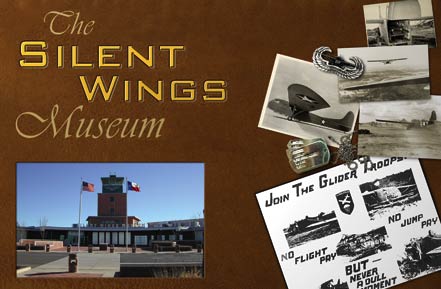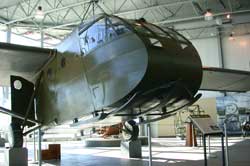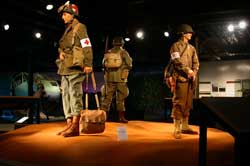|
|
 |
| SW Aviator Magazine is available in print free at FBOs and aviation-related businesses throughout the Southwest or by subscription. |

|
 |

|
 |
 |
 |
|
The web's most comprehensive database of Southwest area aviation events.
|

|
 |

|
 |
|
Featured Site:
|
|
|
 |
|
A continuosly changing collection of links to our favorite aviation related web sites.
|

|
 |

|
 |
 |
|


|
|
Lubbock, TX
|
By John Lorenz
When you hear the phrase, “World War II military aviation,” your thoughts, like mine, probably go to the “famous” designs of the era. The P51, the B17, the P38, and the B29 are the designs that I immediately picture. There were also those planes like the B24 that had a significant impact, but lacked the charisma to be famous.
A recently opened museum in Lubbock, Texas pays tribute to a design that few ever think about, but one that played a significant role in winning the war. The Silent Wings Museum honors the brave men who crashed every time they flew — the glider pilots of World War II.

Gliderswere first used in the war by the Germans to invade Holland. The success of that attack was not lost on allied war planners. In 1941, they asked a number of companies for designs to be submitted for a glider for the U.S. forces. The winning design was submitted by the Waco Company. The CG4 glider was designed to carry a combination of troops and/or supplies. The front of the glider hinged forward to allow Jeeps and other construction equipment to be loaded and unloaded.
The program got off to a rocky start. The first time gliders were used in combat was in Sicily. They were to land on a beach, and the approach was made over water. Many of the gliders were released too far away to make land, and crashed in the ocean too far from land for the soldiers to swim. Approximately 300 men were presumed drowned. Shortly thereafter, in a demonstration flight over St. Louis, a wing separated from a Waco glider carrying the mayor of the city and the President of the Waco Company. All aboard were killed. The military decided to step back and take another look.
Had it not been for a unique approach taken by Major Michael Murphy, the program might well have been scrapped. The Army Air Force had established a tactical testing and training facility at Laurinburg-Maxton Army Air Field in North Carolina. On August 4, 1942, Major Hap Arnold and a planeload of dignitaries arrived for a progress report. Major Murphy was a believer in the glider program. He had been a barnstormer before the war, and if nothing else, knew how to put on a show. He led General Arnold and the rest of the staff through a well-planned sequence of water landings, towing, pick-up operations, and a new technique that allowed a glider to stop in a very short distance. At the end of the day, Major Murphy escorted the entourage to a remote area of the base for a briefing on night landings. The audience expected a straightforward lecture on improvements in night landing techniques. Major Murphy had other ideas.

The lecture began just after dark. The audience sat on small bleachers at the edge of an abandoned “pea patch.” Major Murphy ordered all lights extinguished and began his lecture over a loudspeaker system. The audience could see nothing. All they could do was listen to Major Murphy. As Murphy lectured, several miles away, ten CG4 gliders cut away from their tow plane. They headed for a pathfinder light hidden under a barricade at the end of the pea patch. They had been practicing this for weeks. Murphy’s amplified voice served to cover up the sound of the gliders as they landed 30 seconds apart directly behind Murphy. When the last glider had landed, Murphy ordered the lights turned on. The audience was stunned. Ten huge combat gliders were lined up in front of them. As they continued to stare in disbelief, a nine piece military band emerged from one of the gliders playing an Air Corps marching song. The glider program was never questioned again.
Over 13,000 Waco gliders were built during the war. Very few remain. The Silent Wings museum was formed in 1982 by the National World War II Glider Pilots Association. Originally, the museum was located in Terrell, Texas. Short on funds, in 2000, the collection of the museum was transferred to the City of Lubbock who agreed to fund it as a tourist attraction. Lubbock Army Air Field was one of several bases that trained glider pilots during the war. The flat terrain was particularly suitable for off-field landings, although a number of the other based that were used were located in less hospitable terrain.
 The City of Lubbock had the perfect place for the museum. The old airline terminal building was sitting unused, and with an addition to house the display glider and some other remodeling, the facility opened in October 2002. The City of Lubbock had the perfect place for the museum. The old airline terminal building was sitting unused, and with an addition to house the display glider and some other remodeling, the facility opened in October 2002.
A museum dealing with only one type of aircraft naturally has a limited collection to show, but the CG4 that is on display is in mint condition. In addition to the CG4, a training glider is also on display. There are also other displays of WWII memorabilia. As impressive as the glider itself is, the stories that are told are what truly make an impression. Unarmed and unarmored, these gliders flew into some of the hottest combat zones of the war. They flew low and slow, always susceptible to enemy small arms fire in addition to flak. Landing locations were often less than ideal. The survival rate on landing was not good, but after they got on the ground alive, the fun was just beginning. The pilots had to fight alongside the troops they had delivered. Many died in ground combat. The C47s that pulled the gliders were equally vulnerable.
It was risky, but necessary work. Especially in delivering supplies, nothing else could do the job of the glider. Capable of carrying up to 4,000 pounds, the gliders delivered material that was essential in executing the war against Hitler.

The Silent Wings Museum is open from 10:00 to 6:00 Tuesday through Saturday, and from 1:00 to 5:00 on Sunday. Admission is $4.00 for adults, $3.00 for seniors, and $2.00 for children. If you flew a glider in the war and lived to tell about it, they will let you in free. If you’re flying in to LBB, you can park just outside the museum if you don’t need fuel, or the museum is a short walk from Lubbock Aero. If you’re driving, the museum is located on I-27 on the west side of Lubbock International Airport. Call the museum at 806-775-2047 for more information.
If you’re not familiar with this aspect of military aviation, a visit will give you a new insight on the role of these aircraft in winning the war, and a deeper appreciation for the bravery of the men who flew them.
|
Click here to return to the beginning of this article.  |
|